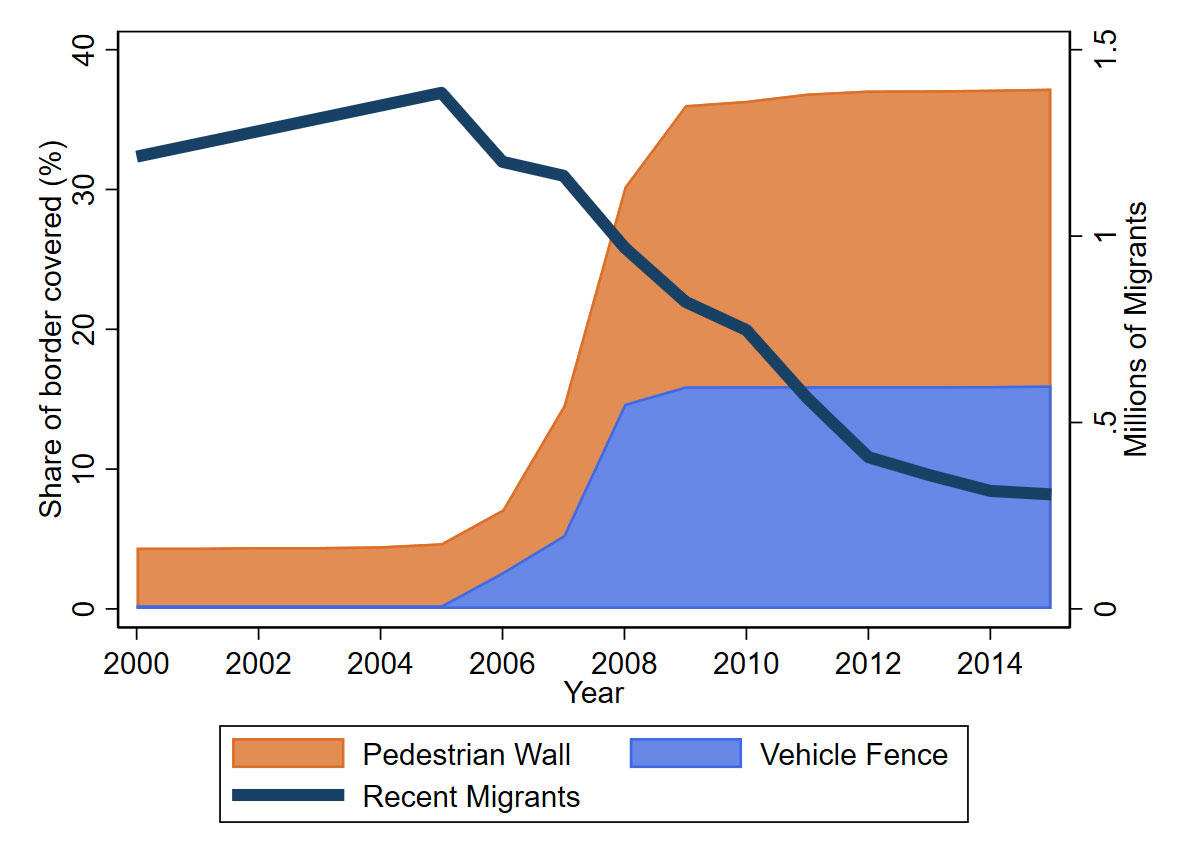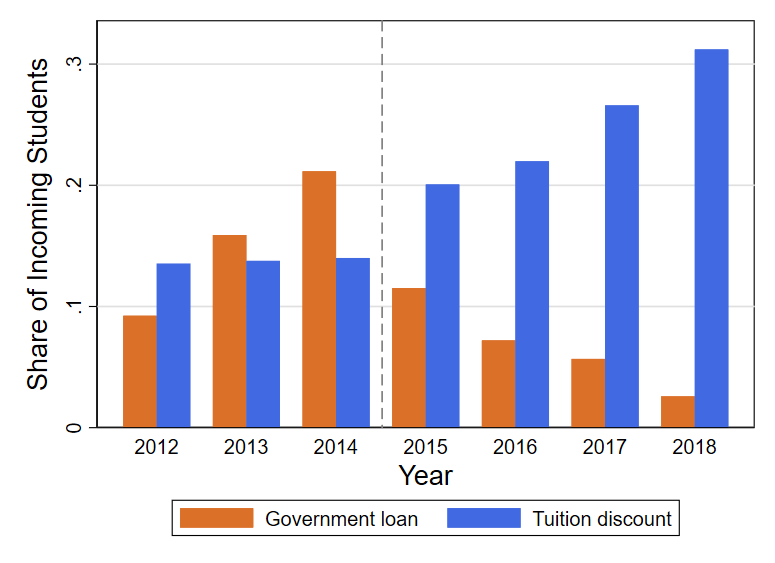

with Nano Barahona and Sebastian Otero
Between 2007 and 2010 the U.S. government built 548 miles of border wall along the U.S.-Mexico border. Using administrative data on 5.7 million (primarily unauthorized) Mexican migrants, we study how the border wall expansion affected migration patterns between Mexican municipalities and U.S. counties. The wall changed migrants’ choice of route and their choice of destination within the United States, but it did not have a large effect on the choice of whether or not to migrate. On net, we estimate the wall decreased annual migration flows by 46,000. Incorporating the decrease in migration into a spatial equilibrium model, we estimate that the wall increased (decreased) wages of low-skill (high-skill) U.S. workers by a modest $2.89 ($3.60) per year.
Media Coverage: The Economist; Bloomberg; CNN; The Washington Post; The Wall Street Journal; NPR; SIEPR; Quartz; Dartmouth News; EurekAlert!; Politico; World Bank Development Impact Blog
We investigate the equilibrium effects of subsidized student loans on tuition costs, enrollment, and student welfare. Two opposing forces make the impact on tuition theoretically ambiguous. First, students with loans become less price-sensitive because they do not bear the total tuition cost, causing tuition to rise (direct effect). Second, loan programs tend to increase the market share of more price-sensitive students, reducing tuition (composition effect). We develop a model of the supply and demand for higher education and estimate it leveraging a large change in the availability of student loans in Brazil. We find that Brazil’s current loan program raises prices by 1.2% and enrollment by 11% relative to a counterfactual without loans. In contrast, we show that an alternative policy that gives loans only to low-income students raises prices by just 0.3% and enrollment by 16%. Most of the difference in enrollment between the two policies are due to price changes coming from a stronger composition effect in the alternative policy.
We study the consequences of affirmative action in centralized college admissions systems. We develop an empirical framework to examine the effects of a large-scale program in Brazil that required all federal institutions to reserve half their seats for socioeconomically and racially marginalized groups. By exploiting admissions cutoffs, we find that marginally benefited students are more likely to attend college and are enrolled at higher-quality degrees four years later. Meanwhile, there are no observed impacts for marginally displaced non-targeted students. To study the effects of larger changes in affirmative action, we estimate a joint model of school choices and potential outcomes. We find that the policy has impacts on college attendance and persistence that imply a virtually one-to-one income transfer from the non-targeted to the targeted group. These findings indicate that introducing affirmative action can increase equity without affecting efficiency.
Media Coverage: Valor Econômico, Nexo, AgênciaBrasil, Exame, R7, OPovo
We investigate the role of firms in intergenerational mobility by decomposing the intergenerational elasticity of earnings (IGE) into firm-IGE and individual-IGE using a two-way fixed effects framework. Using data from Israel, we find that the firm component is responsible for 22% of the overall IGE. We then explore potential mechanisms and find that education differences explain a large share of the individual-IGE, while place of residence and demographics are more important for the firm-IGE. Guided by these empirical patterns, we develop a novel method to estimate the role of skill-based sorting and find that it accounts for approximately half of the firm-IGE. Our results provide evidence that the intergenerational transmission of earnings encompasses more than just human capital, and highlight the importance of promoting equal access to high-paying firms and reducing labor market segregation in efforts to enhance equality of opportunity.
with Nano Barahona, Sebastian Otero, and Constantine Yannelis
This paper studies how schools respond to financial incentives. Governments can penalize institutions with high dropout or loan default rates, and these institutions can respond by increasing quality or changing the selection of students. We build an equilibrium model to illustrate the trade-off faced by policymakers. We study the predictions of the model using a 2017 reform in Brazil, which made schools pay a fee for students receiving federal student loans that dropped out or defaulted. Consistent with the predictions of the model, we find that schools more reliant on government aid reduced dropout rates, primarily by increasing quality.
with Nano Barahona, Sebastian Otero, and Joaquin Fuenzalida
We investigate the costs and benefits of expanding access to online higher education. The net effect of increasing the availability of online degrees on student outcomes is ambiguous and depends on two key objects. First, it depends on whether the demand for online education comes from students substituting away from in-person degrees or students who would otherwise not study. Second, it depends on how the value-added of online degrees and in-person degrees compare. We analyze this issue in the context of the Brazilian higher education market, where the market share of online degrees increased from 21% to 51% between 2015 and 2019. Our setting is compelling for two reasons. First, federal regulation mandates that specific majors, such as Law, can not be offered online. We find that in-person enrollment in majors that allow online education decreased since 2015, but not in those that do not. These patterns suggest that a substantial share of the students enrolling in online education would otherwise enroll in in-person degrees. Second, the Brazilian government offers grants to help students pay for tuition costs. These grants are allocated based on scores, and there are different cutoffs for online and in-person education. Exploring these discontinuities as a natural experiment that nudges students into one type of education or the other allows us to estimate the value added of these two types of degrees.
The Economist ● November 24, 2018
The Washington Post ● January 08, 2019
Exame ● April 16, 2022
CNN ● December 22, 2018
Nexo ● September 01, 2022
Agência Brasil ● April 16, 2022
The Wall Street Journal ● January 07, 2019
R7 ● April 16, 2022
Bloomberg ● November 20, 2018
NPR ● December 14, 2018
OPovo ● April 16, 2022
SIEPR ● November 15, 2018
Quartz ● November 19, 2018
Dartmouth News ● November 21, 2018
EurekAlert! ● November 19, 2018
Politico ● November 16, 2018
World Bank Development Impact Blog ● December 20, 2018
Valor Econômico ● November 20, 2023